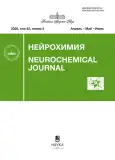Neurochemical Journal
ISSN (print): 1027-8133
Media registration certificate: No. 012649 dated 06/10/1994
Founder: Russian Academy of Sciences, National Academy of Sciences of the Republic of Armenia
Editor-in-Chief Gulyaeva Natalia Valerievna
Number of issues per year: 4
Indexation: RISC, list of Higher Attestation Commissions, CrossRef, White List (level 3)
Current Issue
Vol 42, No 2 (2025)
Special Issue: A Tribute to Nina K. Popova
In Memory of Professor Nina Konstantinovna Popova: Memories of Colleagues and Students
 183-196
183-196


SCIENCE AND LIFE, AND LIFE IS SCIENCE. IN MEMORY OF NINA KONSTANTINOVNA POPOVA
 197-199
197-199


Review Articles
Dual Functions of Mature and Immature Brain Neurotrophins in Regulating Neuroplasticity and Their Modification by Glucocorticoids
Abstract
 200–209
200–209


BIPOLAR AFFECTIVE DISORDER AND CLINICAL DEPRESSION: COMPARATIVE ANALYSIS OF THE SEROTONERGIC SYSTEM ROLE IN PATHOGENESIS AND CORRECTION
Abstract
 210-225
210-225


AUDIOGENIC SEIZURE FITS AND POSTICTAL CATALEPSY IN RATS OF KRUSHINSKY–MOLODKINA STRAIN
Abstract
 226-233
226-233


Experimental Articles
Gene Expression Levels of DNA-Methyltransferases and Histone Deacetylases After Neonatal Dexamethasone Administration and Chronic Unpredictable Stress in Adult Rat Brainstem
Abstract
 234–243
234–243


Clinical Neurochemistry
Evaluation of Mitochondrial Activity in Neural iPSC Derivatives Obtained from a Parkinson’s Disease Patient with Genetic Variant C.1492T>G of GLUD2
Abstract
 244-254
244-254


Regular Articles. Theoretical Articles
POSSIBLE MECHANISM OF REPETITIVE STEREOTYPIC MOVEMENT PATTERNS IN AUTISM SPECTRUM DISORDERS (A ROLE OF NEUROMODULATORS)
Abstract
 255-270
255-270


Regular Articles. Experimental Articles
Molecular and Neurochemical-Level Gears of CNS Response to Combined Impact of Modeled Spaceflight Factors in Rodents
Abstract
 271–279
271–279


Neurochemical Markers of Efficacy of Selective Serotonin Reuptake Inhibitors and Resveratrol in Correcting Anxiety Disorders of Stressful Nature
Abstract
 280-294
280-294


Regular Articles. Clinical Neurochemistry
A Decrease in the Cognitive Status of Patients in the Long Term After Ischemic Stroke is Associated with the Levels of Adrenocorticotropic Hormone and Cortisol in the Hair
Abstract
 295–304
295–304


The Cognitive Status of Patients After Ischemic Stroke is Associated with the Levels of Cytoplasmic Actin 1 and Some Immunoglobulins in Llcam-Positive Extracellular Vesicles of Blood Serum
Abstract
 305-318
305-318












